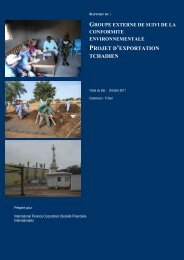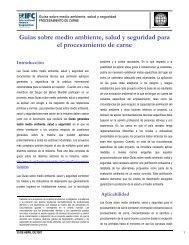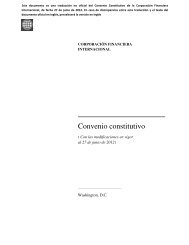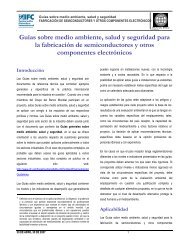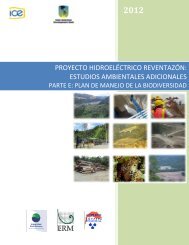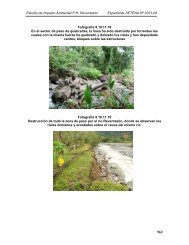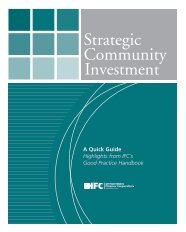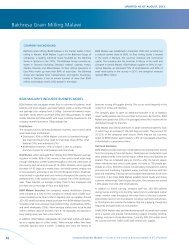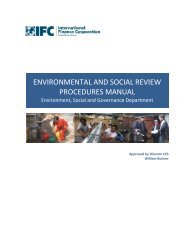CHAD EXPORT PROJECT - IFC
CHAD EXPORT PROJECT - IFC
CHAD EXPORT PROJECT - IFC
Create successful ePaper yourself
Turn your PDF publications into a flip-book with our unique Google optimized e-Paper software.
4 WORKERS AND COMMUNITY HEALTH AND SAFETY<br />
4.1 OCCUPATIONAL HEALTH AND SAFETY MEASURES (EEPCI AND COTCO PERSONNEL)<br />
Project Update<br />
The visits conducted at the OFDA and permanent facilities in Cameroon confirmed that the Health and<br />
Safety measures in place are in line with the current best industry practices and with the EMP requirements<br />
in force. No particular observation or suggestion for improvement was raised.<br />
4.2 OCCUPATIONAL HEALTH AND SAFETY MEASURES (COTCO CONTRACTORS)<br />
Project Update<br />
As previously discussed, the newly issued ROWIP in Cameroon has required an increase of workforce<br />
from the local communities to conduct the periodical maintenance (grass cutting and erosion control) and<br />
inspection (foot patrolling) activities along the pipeline easement. Both activities have started in April<br />
2011.<br />
At the present time, COTCO has three contractors (one per maintenance area) in charge of the ROW<br />
maintenance, plus another three contractors in charge of performing the ROW inspection activities. These<br />
contractors are hiring the needed workforce at the villages located along the pipeline and the local workers<br />
are in charge of inspecting or maintaining the ROW sections pertinent to the relevant village (e.g., the<br />
ROW monitoring and maintenance work load is split based on the length of pipeline section falling within<br />
the territory of the each village). Further details on the ROWIP scope, content and implementation status<br />
are provided under a dedicated section in the present report.<br />
Observations<br />
During the ECMG mission, a sample of villages located in MA4, around the town of Yaoundé, and in<br />
MA3, around the Belabo area, have been visited (see Annex A for details) in order to gather some follow<br />
up from local representatives on the implementation of the ROWIP.<br />
Based on the information provided by the local chiefs and interviewed workers, it appears that all of the<br />
appropriate Personnel Protective Equipment (PPE) was not provided to the workers during the campaigns<br />
conducted in 2011. Further discussion with COTCO EMP representatives has confirmed the concern raised<br />
during the villages visit and the need of further investigating, with the appointed Contractors, that adequate<br />
Health and Safety measures are put in place (including training and provision of PPE). In this sense the<br />
planned contracting of ROW surveyors (see previous section on EMP staffing) could help to provide more<br />
adequate follow up on the quality of the work performed by COTCO contractors.<br />
Recommendation<br />
2. COTCO shall ensure that all the required training and needed PPE (including coverall, boots,<br />
gloves, safety glasses, etc) are provided by the appointed contractors to the locally employed<br />
worker. In general, it is recommended that the monitoring of the COTCO contractors<br />
involved in the ROWIP is further enhanced through the existing CROs and through the<br />
planned new staff to be hired (ROW surveyors).<br />
4.3 REPORTED THEFTS OF EQUIPMENT (<strong>CHAD</strong>)<br />
Project Update<br />
In the period between December 2010 and August 2011 (data set provided), EEPCI has recorded a total of<br />
441 cases of thefts of equipment, mainly cables and transformer oil at well pads. Particular concern was<br />
raised by the Project regarding the increasing episodes of thefts of transformer oil (average of 23 cases per<br />
month since May 2011), which is causing the sudden shut downs of the wells and consequent loss of<br />
production during the time needed for maintenance and repair works.<br />
Observations<br />
This oil, which is a hydrotreated light naphthenic distillate, has known toxicological properties and can<br />
pose risk for human health through skin exposure, inhalation and ingestion (but also presents slow<br />
degradation when released to the environment). Based on the information provided, it is stolen for various<br />
purposes, including mixing with fuel and even use for cooking purposes.<br />
EXTERNAL COMPLIANCE MONITORING GROUP (ECMG)<br />
EIGHTH POST-<strong>PROJECT</strong> COMPLETION VISIT OF THE D’APPOLONIA ECMG, OCTOBER 2011<br />
12


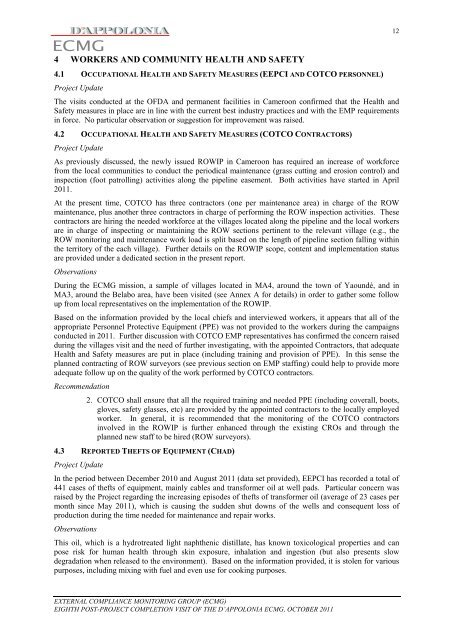
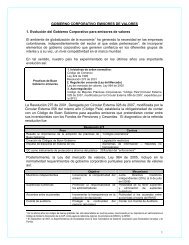
![Business Membership Organizations [pdf] - IFC](https://img.yumpu.com/15413100/1/190x245/business-membership-organizations-pdf-ifc.jpg?quality=85)
